Medical expert of the article
New publications
Preparations
Ointments for the eyes from inflammation
Last reviewed: 23.04.2024

All iLive content is medically reviewed or fact checked to ensure as much factual accuracy as possible.
We have strict sourcing guidelines and only link to reputable media sites, academic research institutions and, whenever possible, medically peer reviewed studies. Note that the numbers in parentheses ([1], [2], etc.) are clickable links to these studies.
If you feel that any of our content is inaccurate, out-of-date, or otherwise questionable, please select it and press Ctrl + Enter.

Indications for the use of ointments for the eyes from inflammation
Ointment for eyes from inflammation is used to treat conjunctivitis, as well as keratitis of various etiologies. As a rule, such drugs are included in complex therapy. They are rarely used on their own. Also it is necessary to pay attention that the inflammation of the eyes can be caused not only by viruses, but also by fungi, bacteria (including chlamydia). Also, inflammation can be allergic.
Form of issue
To date, pharmacies can find a large number of different drugs that are designed to treat inflammation of the eyes. Ointments are considered to be one of the most popular. Ophthalmologists believe that it is this form of release that best copes with diseases of the eyes of the viral and fungal nature best of all, since it has a viscous structure.
Due to its consistency, the ointment is much better distributed over the surface of the eyelid, which has a therapeutic effect on rather long time intervals. Also, the patient can independently control the dose of the drug, while it is difficult to do with drops.
To achieve a positive result, ointment for the eyes from inflammation is recommended to be applied overnight. Especially since you will not suffer from temporary impairment of vision, since you will be sleeping.
Ointments are often used for burns, viral infections, erosions and external injuries.

Pharmacodynamics and pharmacokinetics
Consider the pharmacodynamics of ointments for the eyes from inflammation with the example of the popular drug "Acyclovir", which can be used even for the treatment of children.
The agent is active against such viruses as Herpes simplex, Epstein-Barra and Varicella zoster. Most often it is used for the therapy of conjunctivitis, which was caused by herpes. Acyclovir, entering the infected cells, is phosphorylated and converted to acyclovir monophosphate. Later it becomes a diphosphate under the influence of guanylate cyclase. When some cellular enzymes act on the diphosphate, it becomes a triphosphate.
It is the acyclovir triphosphate that starts to integrate into the DNA of the virus, which blocks its multiplication.
Due to its structure, the ointment quickly and without problems penetrates into the deep layers of the corneal epithelium, which causes a greater concentration of its main component in the intraocular fluid. With external use, the drug can only be detected in the patient's urine, but in such a small amount that it has no therapeutic significance.
Names of ointments for the eyes from inflammation
If you notice that you have started to get inflamed, first of all, you need to go to the doctor's examination. Only he can make the right diagnosis and prescribe suitable therapy. What kind of ointments help with different types of conjunctivitis?
With bacterial (including chlamydial) conjunctivitis:
- Erythromycin ointment. Active active ingredient is erythromycin, an antibiotic that belongs to the group of macrolides. It is active against many Gram-positive bacteria, but most often it is prescribed for the treatment of eyes from chlamydia, ureaplasma and mycoplasma.
Ointment is used at least three times a day. It is usually laid under the lower eyelid. Can be used to treat inflammation in children. The course continues until all the symptoms of the disease disappear. But the treatment should not be continued after two weeks.
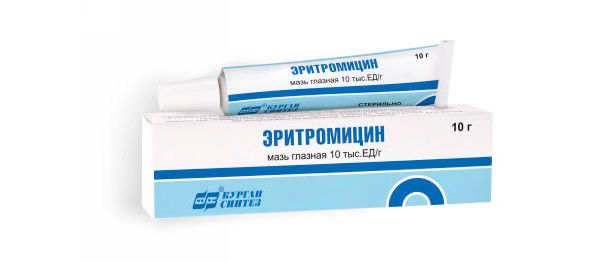
The drug is contraindicated for intolerance of its components and for any pathology of the liver. Sometimes the use of ointment can lead to undesirable local and allergic reactions of varying severity.
- Tobrex. Active active substance of the ointment is tobramycin sulfate. It is an antibiotic that has high bactericidal properties against many Gram-positive and Gram-negative bacterial agents (in particular, staphylococci, streptococci, some types of Neisseria, Klebsiella, Proteins).
Fill in a small amount in the lower eyelid every four hours. The course of therapy lasts five to seven days.
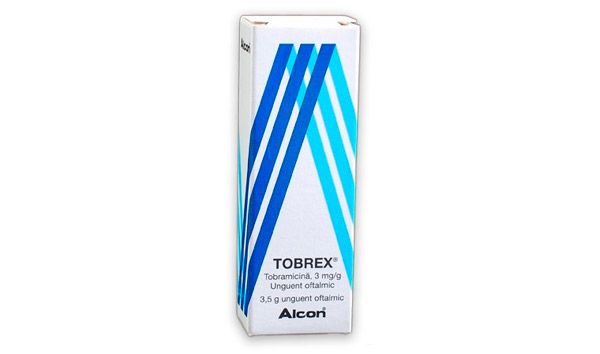
The drug is not recommended for children under 18 years. It is also contraindicated in case of intolerance of its components. Among the most popular side effects doctors singled out: eyelid swelling, allergy, itching, flushing.
Viral conjunctivitis is treated with such ointments:
- Bonaphoton. Active active substance of this agent is bromonaphthoquinone. This antiviral drug is particularly active in relation to Herpes simplex.
For application under the eyelid, a small layer of ointment (about 1 cm) is used. Use should be at least three to four times a day. Treatment lasts from five to twelve days, depending on the type of disease.
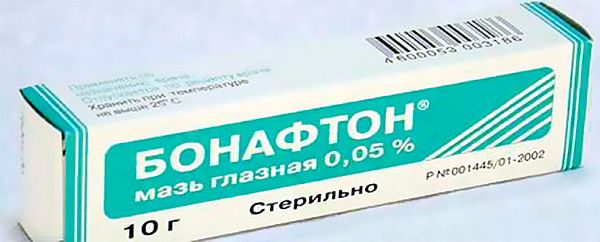
The drug is forbidden to use during pregnancy and lactation, up to 18 years, and also with intolerance of its components. Sometimes side effects are possible: burning, allergy, blurred vision.
- Zovirax. Active active component of the ointment is acyclovir. It is characterized by activity in relation to Varicella zoster and Herpes simplex.
The drug can be used from childhood. Apply a thin strip under the eyelid (about 10 mm). Use at least five times a day. Between applications, at least four hours must pass. After healing and disappearance of symptoms, therapy continues for another three days.
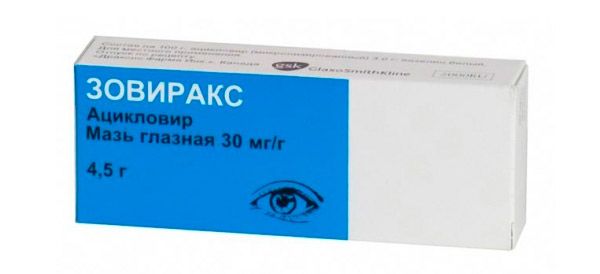
If you do not carry the components of the tool, it is not recommended to use it. Pregnant women can use the product only under the supervision of the attending physician. Sometimes, when using ointments, allergic reactions of varying severity, keratopathy of the surface type, blepharitis occur.
When allergic conjunctivitis, as a rule, use eye drops. But if you prefer to use for the treatment of ointment, then it is worth paying attention to the following:
- Tebridex. Active active substances of the ointment are: hormonal substance dexamethasone and antibiotic tobramycin.
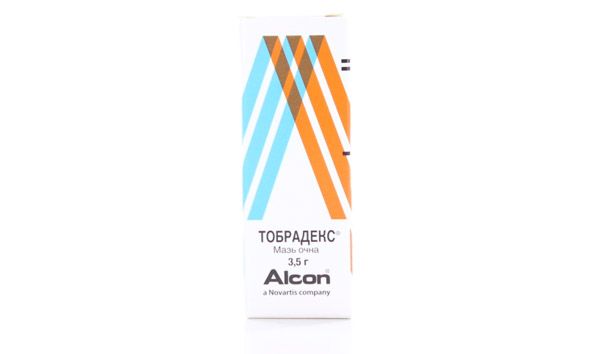
Use at least three to four times a day, applying a thin layer under the lower eyelid (1.5 cm). The frequency of application should be reduced when the patient's condition improves. You can combine the ointment with drops of Tevodex.
The drug is not recommended for the treatment of inflammatory processes of the eyes of viral etiology, fungal and purulent ophthalmic diseases, and also during breastfeeding, up to 18 years after the foreign body has been removed from the cornea.
Sometimes, when using the ointment, side effects can occur: uncomfortable discomfort, burning, allergy, itching, eyelid swelling, headaches, rhinorrhea, secondary bacterial infections.
- Drops Garazon. Active active ingredients of the drug are: gentamicin and betamethasone. It differs in anti-inflammatory, antipruritic and anti-exudative action.
Bury drops from three to four times a day under the lower eyelid, 1 drop in each eye. If the disease is acute, you can use the drug every two hours. With chronic diseases, therapy is gradually phased out.
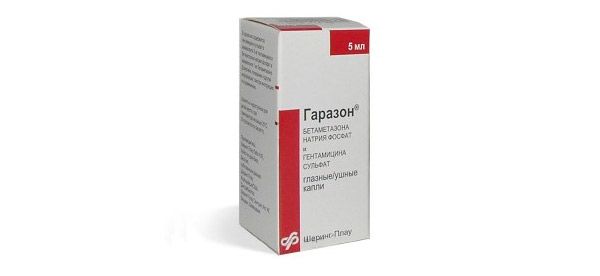
Drops should not be taken with intolerance of its components, fungal diseases, trachoma, eye tumors, acute viral diseases, during child bearing, up to six years. During the use of the drug, the patient can, in some cases, feel burning and tingling in the eyes, eyelids can swell. Also among the side effects can be identified: glaucoma, cataracts, anterior uveitis, mydriasis.
Ointment Tetracycline
Tetracycline ointment is most often used to treat bacterial conjunctivitis. The active component of the drug is the antibiotic tetracycline, which has a rather broad spectrum of action (it acts bacterically on: brucellae, campylobacteria, listeria, neyerii, actinomycetes, balantidia, borrelia, streptococci (except for beta-hemolytic streptococcus group A), clostridia, mycoplasmas, propionobacteria , treponema, ureaplasma). It is recommended to apply the drug under the lower eyelid three to five times a day, using a thin layer.
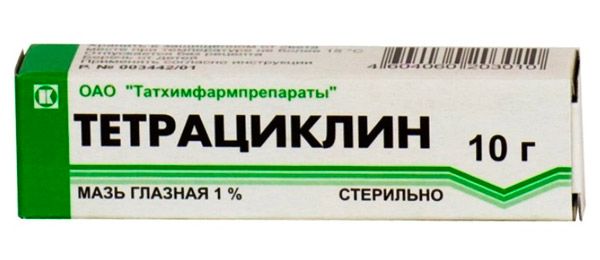
It is not recommended for use in: the inflammatory process in the eye of viral and fungal etiology, children under five years of age, intolerance of its main component, during childbearing and breastfeeding.
Often, Ointment Tetracycline can cause photosensitization, in which the eyes become too sensitive to sunlight. Sometimes, patients may develop allergic reactions (burning, swelling, redness). If the ointment is used for too long, side effects from the gastrointestinal tract are possible.
Ointments for the eyes from inflammation and redness
The main task of any ointment for the eyes is to provide anti-inflammatory and anti-allergic action. Very often, the inflammatory process is accompanied by redness in the eye area. In order to remove these unpleasant symptoms use a variety of drugs, but the most effective of them is Hydrocortisone ointment.
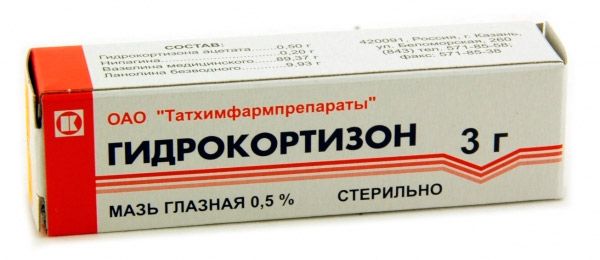
Active active ingredient of the drug is hydrocortisone acetate, which belongs to the group of glucocorticosteroid agents. It differs anti-allergic, anti-inflammatory, anti-edematous and antipruritic effect. Thanks to the basic substance, the agent makes it difficult to migrate leukocytes and lymphocytes to the area of inflammation and reduces the permeability of capillaries.
The doctor can recommend the use of Hydrocortisol ointment in such cases:
- Allergic conjunctivitis.
- Inflammation of the anterior part of the eye, when the cornea remains unaffected by the pathological process.
- Burns of the eye (chemical and thermal).
- After traumatic injuries and surgical operations.
Among the main side effects from the use of the remedy can be called: allergy, burning, nebula vision for a while. Ointment is contraindicated in: trachoma, violations of the integrity of the surface of the eye, viral, fungal and bacterial diseases, primary glaucoma, intolerance of the main components.
Application: 1 cm of ointment to lay down the lower eyelid 2-3 times a day. The therapy lasts one to two weeks. If necessary, the doctor can increase the time of use of the drug. It is not recommended to renew the course on your own.
The analogue of this drug is the ointment "Maxidex".
Ointment for eyes from inflammation for children
When the inflammatory process in the eye in children is not recommended to use ointments, which are based on an antibiotic. Breast children are most often afflicted with dacryocysts. The most common diseases in older children are different conjunctivitis. For treatment popular ointments are used. Among them, it is especially worth mentioning:
Acyclovir. It is a popular antiviral drug, active ingredient of which is acyclovir. A small amount of ointment (about 1 cm) is placed behind the lower eyelid. Use recommended up to five times a day every four hours. The therapy continues until the symptoms disappear completely, but it is worth continuing to use the drug once a day for three more days.
The drug can be given to children from infancy, but it is contraindicated for women who breast-feed, and with intolerance of the components of the drug. Among the main side effects can be identified: swelling, burning, blepharitis.
Dosing and Administration
Before applying ointments for the eyes from inflammation, you need to remember some important rules:
- Wash your hands thoroughly before putting the product on the site of inflammation.
- Use disposable sterile strips to help determine the correct dosage.
- To find out what dosage you need, it is necessary to take into account that the amount of ointment should be completely placed under the eyelid.
- If you wear contact lenses, they must be removed and not worn for several hours before application.
- Do not touch the tip of the tube with eyes.
- Close the tube tightly after use.
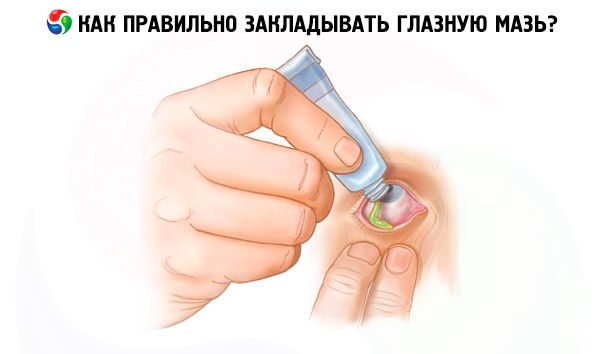
Use ointments for the eyes from inflammation during pregnancy
As a rule, most of these medicines are not recommended for use by pregnant women. Only in very rare cases, the doctor can prescribe an ointment from inflammation of the eyes.
Contraindications to the use and side effects of ointments for the eyes from inflammation
First of all, such drugs should not be used if their active ingredients are intolerant. Also some ointments are prohibited in viral or fungal diseases, since they act primarily on the inflammation of bacterial or allergic etiology. When breastfeeding, during pregnancy and (in some cases) to 18 years, eye ointments for inflammation are also contraindicated.
Most often, when using such drugs in patients, there may be various allergic reactions (burning, puffiness of the eyelids, redness, itching), which quickly pass after stopping the use of the ointment. Also among the side effects are: secondary bacterial infection, blurred vision, headaches.
Overdose and interactions with other drugs
Overdose ointment for eyes from inflammation is possible only if the child accidentally swallowed a small amount of the drug. The following symptoms occur: migraine, nausea and vomiting, shortness of breath, diarrhea, convulsions and even coma.
As a rule, such drugs interact well with other drugs. But before using, you should carefully study the instructions.
Storage conditions and shelf life
It is important to store the ointments in places inaccessible to small children. The air temperature should be about 15-25 degrees.
As a rule, ointments for the eyes from inflammation can be stored for about three years. Remember, after the tube with the product has been opened, the shelf life is dramatically reduced.
Attention!
To simplify the perception of information, this instruction for use of the drug "Ointments for the eyes from inflammation" translated and presented in a special form on the basis of the official instructions for medical use of the drug. Before use read the annotation that came directly to medicines.
Description provided for informational purposes and is not a guide to self-healing. The need for this drug, the purpose of the treatment regimen, methods and dose of the drug is determined solely by the attending physician. Self-medication is dangerous for your health.

